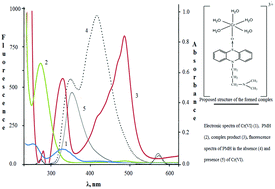A promazine derivative-oriented chemical sensor for ultra-sensitive chromium determination
Abstract
The study reports a simple and highly selective spectrofluorometric method for trace determination and speciation of chromium(III & VI) species in water using 10-(3-dimethylaminopropyl) phenothiazine hydrochloride, namely, promazine hydrochloride (PMH) as a fluorescence tagging reagent. The method is based on the redox reaction between PMH and chromium(VI) in aqueous H3PO4, resulting in the formation of complex [Cr(III)–PMH] followed by fluorescence quenching at λex/em = 300/449 nm. An exceptional value for the limit of detection (LOD = 0.03 μg L−1) is attained with a linear range of 0.1–1.0 μg L−1 under the optimized conditions. A coefficient of variation (CV) of ±2.05% (n = 5) is obtained at 2.0 μg L−1 level of chromium(VI). Chemical speciation of the chromium(III & VI) species is successfully accomplished after the oxidation of chromium(III) to chromium(VI) with H2O2 in KOH solution at pH 9.0. The method is validated in environmental water samples with satisfactory recovery percentages (>97.7%) using inductively coupled plasma-optical emission spectrometry (ICP-OES). The proposed and reference methods are subjected to statistical treatment (student's t and F tests) at 95% confidence with no significant difference, indicating the precision and accuracy of the proposed optical probe.



 Please wait while we load your content...
Please wait while we load your content...